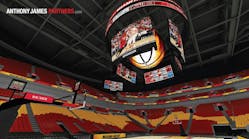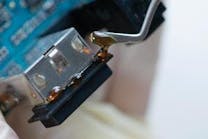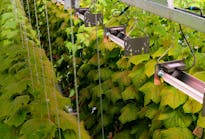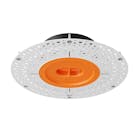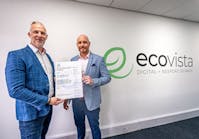DesignLights Consortium Provides a First Look at New Draft Performance Standards for Commercial LED Lighting
Feb. 1, 2019
New Qualified Products List requirements would maintain focus on energy efficiency, while stressing importance of “quality of light” for human health and well-being
MEDFORD, MA – Jan. 29, 2019 – While continuing a decade-long push to maximize efficacy and energy efficiency in commercial lighting, the DesignLights Consortium (DLC) today unveiled the first draft of a new policy that puts new and significant emphasis on quality of light as a bar products must clear for inclusion on the DLC’s Qualified Products List (QPL).
The DLC is a central resource for the lighting industry, utilities and others seeking to glean more efficiency from LED technologies, informing the design of energy efficient lighting incentive programs offered by scores of utility companies across North America. The DLC has boosted efficiency standards three times since publication of its initial QPL in 2009 – increasing required efficiency by 20 to 30 percent (depending on product type) in 2013, introducing a “premium” designation worthy of higher utility incentives in 2015, and upping the efficiency ante again by 30 to 40 percent in 2016.
Based on science and stakeholder input and scheduled to take effect in 2020, the DLC’s new V5.0 performance specification takes a fresh tack on LEDs, underscoring the significance of “quality of light”– defined as aspects of light that impact people’s productivity, performance, comfort, mood, safety, health, wellbeing and more. Under the policy, a product’s listing on the QPL will require reporting on attributes such as color quality, glare, flicker, and optical distribution, giving lighting decision makers the tools they need to identify high performing products for applications where quality of light is important.
The first draft of V5.0 is at a conceptual level and does not include detailed product requirements that will appear in the final version. As it develops the final policy, the DLC is seeking stakeholder input. Comments on the first draft are due by March 12 (https://www.designlights.org/workplan/technical-requirements-v5-0/). Stakeholders can also register for a webinar the DLC will host to review the purpose and content of V5.0 and answer questions on Feb. 13 at 1 p.m.
“As research improves our understanding of how light affects human health, wellness, and productivity, it’s essential to support development and installation of products whose virtues go beyond saving energy,” DLC Executive Director Christina Halfpenny said. “The DLC’s goal with this new policy is to balance a push for ever-increasing energy efficiency with assurance that illumination of offices, hospitals, schools and other C&I spaces supports human comfort and well-being.”
Halfpenny noted that quality of light metrics for alertness, sleep, circadian wellbeing and other considerations are not absolute – i.e., what qualifies as high quality light for one application or to one user may differ for another – and that will be reflected in the DLC’s final policy.
The DLC’s V5.0 requirements come in the midst of rapid technology advances and market shifts occurring since LEDs entered the general lighting scene around 2010. As the LED market has matured, a drive to reduce production costs in the face of mounting competition has tended to sideline the importance of product quality aspects such as glare control, optical distribution, color quality, and reduced flicker. By contrast, the DLC is now moving to favor efficient lighting products that also provide an array of non-energy benefits, from improving workplace performance and safety, to reducing eye strain and headaches and boosting mood.
The new specification will also point the LED market in a more controls-friendly direction. Since LEDs installed now may run for a decade or more, ignoring controls (such as the ability to dim, at minimum) at the time of installation could strand potential energy and cost savings for years to come.
In keeping with past practice, V.50 will again increase minimum efficacy requirements for QPL listing. The DLC is currently conducting research to determine what level of efficacy is realistic by January 2020 without sacrificing quality of light or product reliability.
On the heels of the initial comment period running through March 12, the DLC invites further discussion at its 2019 DLC Stakeholder Meeting in St. Louis, MO, a highly interactive working meeting that will focus on changes to the V5.0 draft requirements.
###
About DesignLights Consortium: The DesignLights Consortium® (DLC) is a non-profit organization dedicated to accelerating the widespread adoption of high-performing commercial lighting solutions. The DLC promotes high-quality, energy-efficient lighting products in collaboration with utilities and energy efficiency program members, manufacturers, lighting designers, and federal, state, and local entities. Through these partnerships, the DLC establishes product quality specifications, facilitates thought leadership, and provides information, education, tools and technical expertise.
MEDFORD, MA – Jan. 29, 2019 – While continuing a decade-long push to maximize efficacy and energy efficiency in commercial lighting, the DesignLights Consortium (DLC) today unveiled the first draft of a new policy that puts new and significant emphasis on quality of light as a bar products must clear for inclusion on the DLC’s Qualified Products List (QPL).
The DLC is a central resource for the lighting industry, utilities and others seeking to glean more efficiency from LED technologies, informing the design of energy efficient lighting incentive programs offered by scores of utility companies across North America. The DLC has boosted efficiency standards three times since publication of its initial QPL in 2009 – increasing required efficiency by 20 to 30 percent (depending on product type) in 2013, introducing a “premium” designation worthy of higher utility incentives in 2015, and upping the efficiency ante again by 30 to 40 percent in 2016.
Based on science and stakeholder input and scheduled to take effect in 2020, the DLC’s new V5.0 performance specification takes a fresh tack on LEDs, underscoring the significance of “quality of light”– defined as aspects of light that impact people’s productivity, performance, comfort, mood, safety, health, wellbeing and more. Under the policy, a product’s listing on the QPL will require reporting on attributes such as color quality, glare, flicker, and optical distribution, giving lighting decision makers the tools they need to identify high performing products for applications where quality of light is important.
The first draft of V5.0 is at a conceptual level and does not include detailed product requirements that will appear in the final version. As it develops the final policy, the DLC is seeking stakeholder input. Comments on the first draft are due by March 12 (https://www.designlights.org/workplan/technical-requirements-v5-0/). Stakeholders can also register for a webinar the DLC will host to review the purpose and content of V5.0 and answer questions on Feb. 13 at 1 p.m.
“As research improves our understanding of how light affects human health, wellness, and productivity, it’s essential to support development and installation of products whose virtues go beyond saving energy,” DLC Executive Director Christina Halfpenny said. “The DLC’s goal with this new policy is to balance a push for ever-increasing energy efficiency with assurance that illumination of offices, hospitals, schools and other C&I spaces supports human comfort and well-being.”
Halfpenny noted that quality of light metrics for alertness, sleep, circadian wellbeing and other considerations are not absolute – i.e., what qualifies as high quality light for one application or to one user may differ for another – and that will be reflected in the DLC’s final policy.
The DLC’s V5.0 requirements come in the midst of rapid technology advances and market shifts occurring since LEDs entered the general lighting scene around 2010. As the LED market has matured, a drive to reduce production costs in the face of mounting competition has tended to sideline the importance of product quality aspects such as glare control, optical distribution, color quality, and reduced flicker. By contrast, the DLC is now moving to favor efficient lighting products that also provide an array of non-energy benefits, from improving workplace performance and safety, to reducing eye strain and headaches and boosting mood.
The new specification will also point the LED market in a more controls-friendly direction. Since LEDs installed now may run for a decade or more, ignoring controls (such as the ability to dim, at minimum) at the time of installation could strand potential energy and cost savings for years to come.
In keeping with past practice, V.50 will again increase minimum efficacy requirements for QPL listing. The DLC is currently conducting research to determine what level of efficacy is realistic by January 2020 without sacrificing quality of light or product reliability.
On the heels of the initial comment period running through March 12, the DLC invites further discussion at its 2019 DLC Stakeholder Meeting in St. Louis, MO, a highly interactive working meeting that will focus on changes to the V5.0 draft requirements.
###
About DesignLights Consortium: The DesignLights Consortium® (DLC) is a non-profit organization dedicated to accelerating the widespread adoption of high-performing commercial lighting solutions. The DLC promotes high-quality, energy-efficient lighting products in collaboration with utilities and energy efficiency program members, manufacturers, lighting designers, and federal, state, and local entities. Through these partnerships, the DLC establishes product quality specifications, facilitates thought leadership, and provides information, education, tools and technical expertise.
